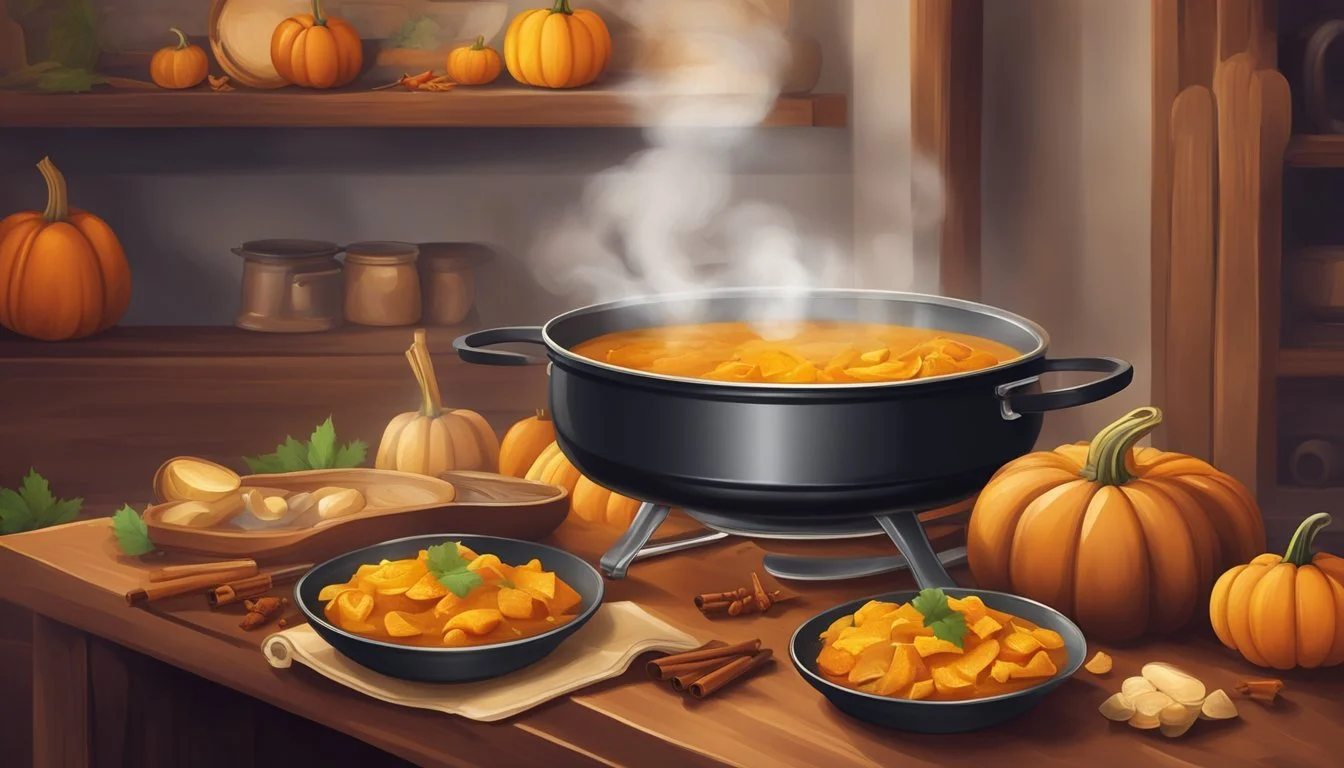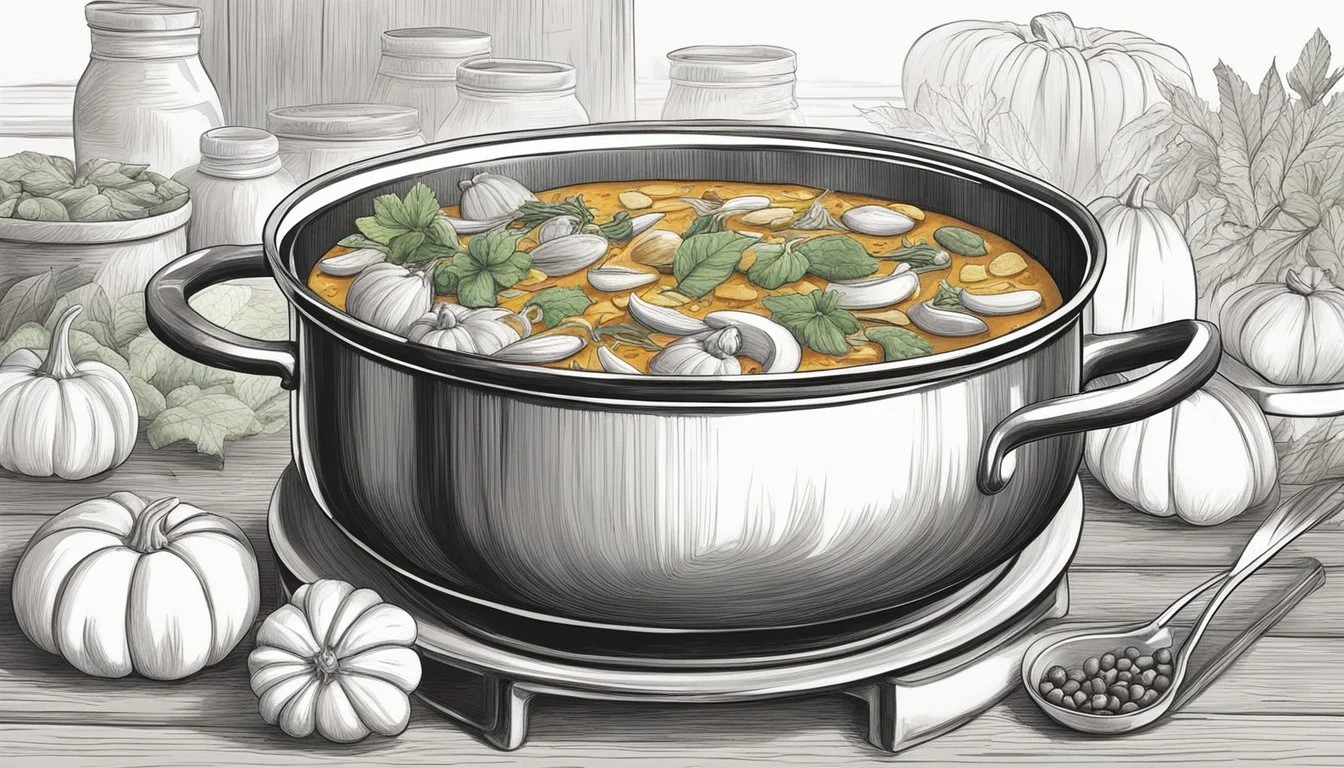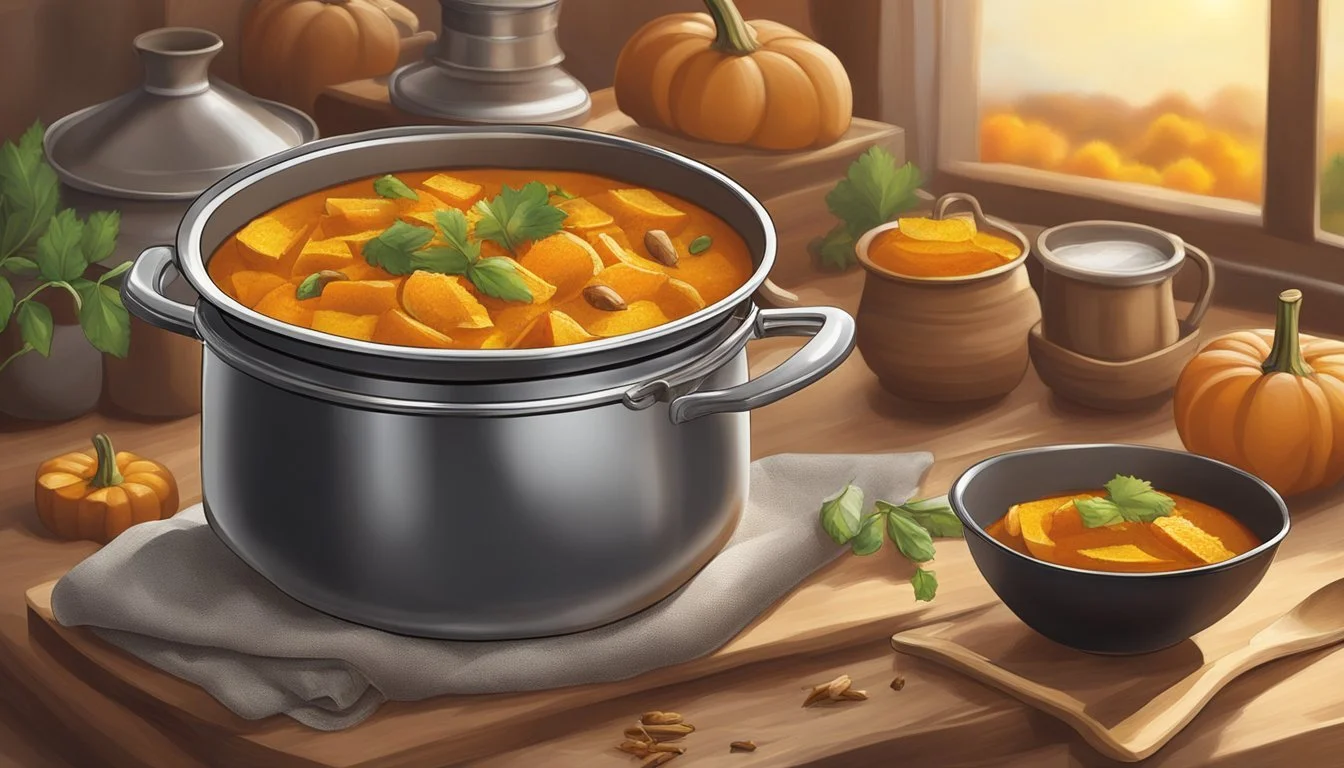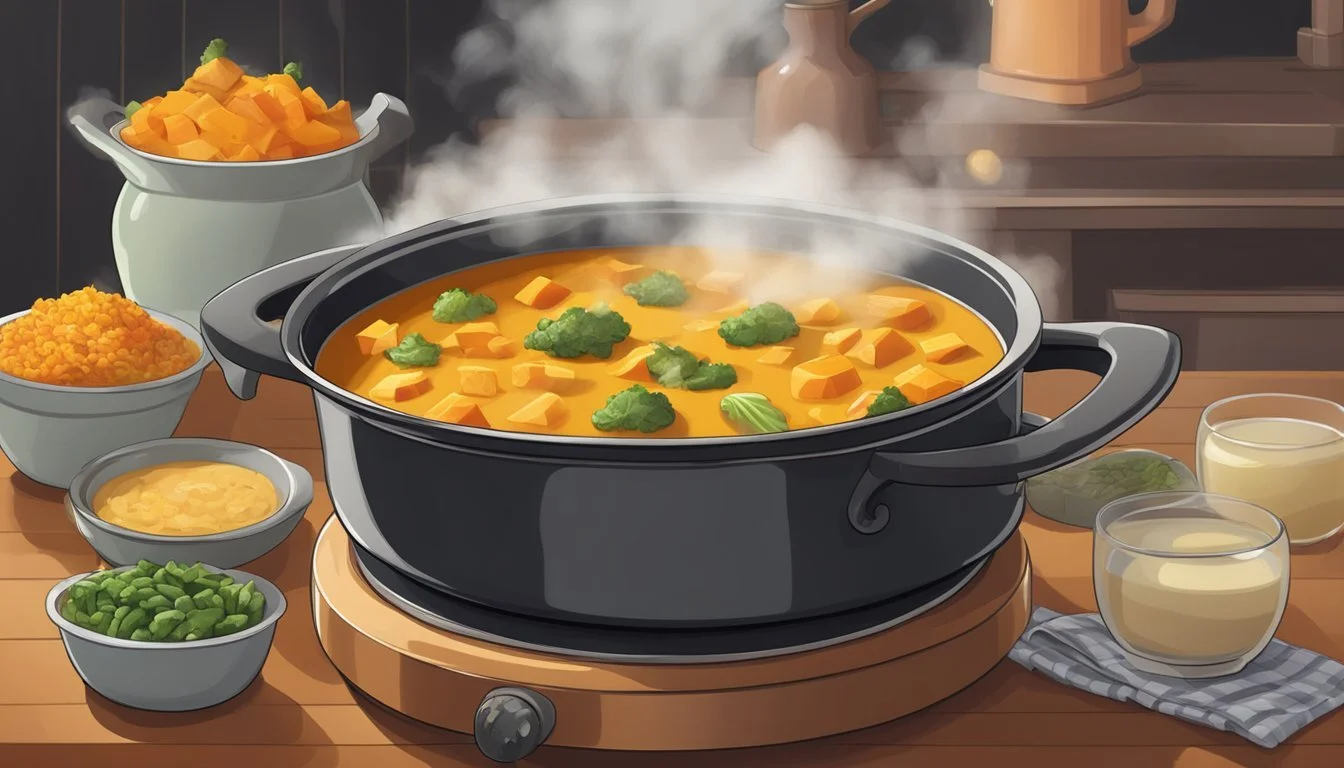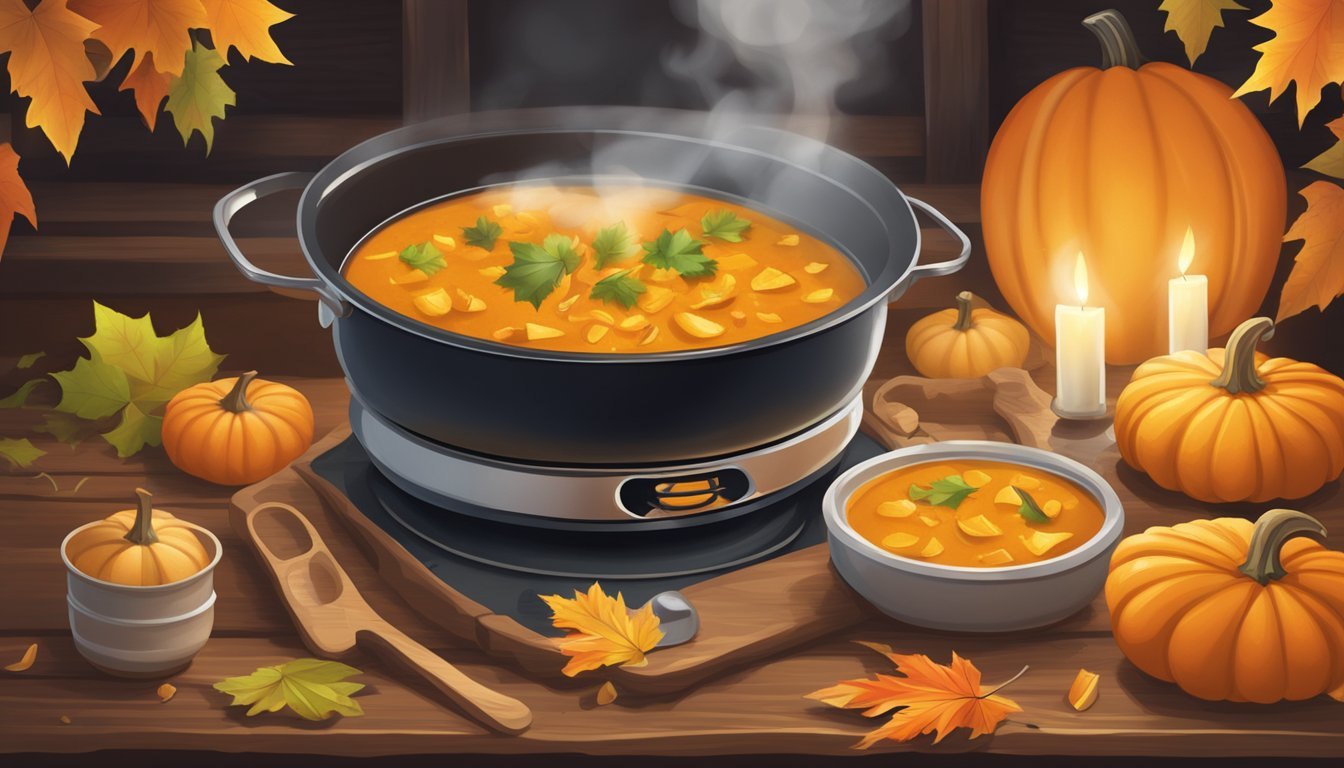Pumpkin Peel Curry
A Flavorful Twist on Comfort Food for Chilly Evenings
Pumpkin peel curry emerges as a unique twist on traditional autumnal fare, leveraging the often-discarded skins of pumpkins to craft a sustainable and heartwarming main course. With the growing emphasis on root-to-stem cooking, this dish epitomizes ingenuity in the kitchen, transforming the robust peels into a flavorful component of a creamy curry. As the chilly air ushers in the desire for comfort foods, this curry offers a comforting warmth with its blend of spices and velvety texture, making it a perfect centerpiece for a fall meal.
Utilizing the full bounty of the season, pumpkin peel curry is not only an exercise in flavor but also in mindfulness towards reducing food waste. The peels, rich in fiber and nutrients, are simmered with an array of aromatic spices and herbs, reflecting the harvest palette in every spoonful. This dish serves as a testament to the versatility of pumpkin, proving that every part of this autumnal staple can be celebrated and savored in a culinary context.
Accompanied by a variety of complementary ingredients such as coconut milk for creaminess, and a touch of maple syrup for a subtle sweetness, pumpkin peel curry balances the vibrant flavors of fall with nutritional benefits. Whether one is a seasoned cook or a culinary novice, this dish is accessible and open to interpretation, inviting all to savor the essence of the season through a sustainable and delectable approach to cooking.
The Essence of Pumpkin Curry
Pumpkin Curry represents a perfect blend of sweet, earthy pumpkin with the bold, complex flavors of a range of spices commonly found in Indian cuisine.
Defining Pumpkin Curry
Pumpkin Curry involves cooking pumpkin, a versatile winter squash, with a mixture of aromatic spices, often resulting in a rich, creamy sauce. The key to its flavor lies in the use of curry powder and often includes a compass of Indian spices such as turmeric, cumin, and garam masala.
The Role of Pumpkin in Curry
In this dish, pumpkin is not just an add-in; it's the star. It provides a robust base that absorbs and amalgamates the diverse flavors of the spices. Pumpkin, with its creamy texture when cooked, also naturally thickens the curry, negating the need for additional thickening agents.
Variations of Pumpkin Curry
Various interpretations of Pumpkin Curry exist, with recipes often tailored according to region or personal preference. Here's a brief overview:
Traditional Indian Pumpkin Curry: Utilizes garam masala, a blend of ground spices, including peppercorns, cloves, cinnamon, nutmeg, and others.
Western Adaptations: May use pre-made curry powder, typically a mix containing turmeric, coriander, cumin, and chili pepper.
Each variation has its own unique profile, but they all maintain the central theme of marrying the sweetness of pumpkin with the depth of spicy flavors.
Selection and Preparation of Ingredients
Before embarking on the creation of Pumpkin Peel Curry, one must give careful attention to selecting the finest ingredients, ensuring freshness and quality. Correct preparation techniques amplify flavors and enrich the overall culinary experience.
Choosing the Right Pumpkin
For the pumpkin, one should look for sugar pumpkins or pie pumpkins. These varieties are smaller but denser and sweeter than their jack-o'-lantern counterparts. The skin should be firm, and the pumpkin should feel heavy for its size. Ensure that the pumpkin is free of blemishes or soft spots which could indicate spoilage.
Essential Fresh Produce
The success of the curry leans heavily on the freshness of produce. They need onions that are firm and pungent, garlic that is plump with intact cloves, and ginger with a smooth, taut skin. Each of these should be fresh to provide the essential aromatic base that defines any good curry. Fresh cilantro is also pivotal, contributing both to the garnish and the delicate herby notes within the dish.
Sourcing Spices and Herbs
Spices and herbs are the soul of a Pumpkin Peel Curry. They must procure:
Cumin seeds: for their earthy and nutty flavor
Mustard seeds: for a sharp and rustic quality
Fenugreek seeds: for their sweet, nutty undertones
Asafoetida (Hing): for a unique umami touch.
Curry leaves: for their complex, citrusy fragrance
They are advised to source these spices from a reputable vendor to guarantee their potency and authenticity. The herbs and spices should be devoid of any clumps or moisture, signs of freshness and proper storage.
Culinary Techniques and Cooking Methods
When crafting a flavorful Pumpkin Peel Curry, three fundamental cooking techniques are essential: roasting, sautéeing, and simmering. Each method contributes to the development of the dish's rich taste and comforting texture.
Roasting Pumpkin
Roasting pumpkin intensifies its sweetness and adds a caramelized texture that enhances the curry's depth of flavor. One begins by peeling and seeding the pumpkin, cutting it into uniform chunks for even cooking. The oven is typically preheated to 120 degrees Celsius, and roasting time varies, but a golden-brown, fork-tender finish is the goal. One may also roast the seeds separately for a crunchy garnish.
Preheat oven to 120°C.
Cut pumpkin into 4cm chunks.
Place chunks on a baking sheet.
Roast until golden and tender.
Sautéing Aromatics
Sautéing aromatics is the next step. Ingredients like onions, shallots, garlic, chillies, and ginger are crucial for building a flavor base. They are cooked in a generous amount of olive oil or coconut oil over medium heat until softened. This process releases their essential oils, imparting a complex aroma and foundation to the curry.
Heat olive oil or coconut oil in a pan.
Sauté onions, shallots, garlic, chillies, and ginger.
Cook until they are translucent and aromatic.
Simmering the Curry
Simmering allows the flavors to meld and the pumpkin to fully absorb the spices. Add the roasted pumpkin to the pan with sautéed aromatics, along with curry paste or powder, and a liquid like stock or coconut milk. The ingredients are brought to a boil, then reduced to a gentle simmer. The curry simmers until the pumpkin is tender and the sauce has thickened to the desired consistency.
Combine: roasted pumpkin with aromatics.
Add stock or coconut milk.
Simmer until pumpkin is tender and sauce thickens.
Building Layers of Flavor
In crafting an autumnal pumpkin peel curry, the complexity of taste emerges from a careful application of spices and the development of a robust curry sauce.
Spice Blends and Seasoning
To infuse the curry with depth and warmth, chefs begin by selecting a harmony of spices. Turmeric provides an earthy backbone, noted for its bright yellow hue and subtle bitter notes. Cumin and coriander are integral, offering their distinct warm and citrusy undertones. Accurately toasting these spices is key; it heightens their flavor profiles and releases essential oils that are central to the dish’s aromatic qualities.
The spices should be sautéed until fragrant before other ingredients join the fray, ensuring that the seasoning is well-integrated and lays a solid foundation for further components.
Creating a Rich Curry Sauce
The curry sauce is crucial, as it carries all the individual flavors and spices to form a cohesive and indulgent main course. Start by simmering tomatoes to build a tangy and robust base. This acidity balances the richness that will come from the next critical ingredient: coconut milk. The coconut milk is responsible for the creaminess of the sauce and complements the spices by adding a hint of sweetness and a velvety texture.
It's imperative to add the coconut milk slowly and allow the curry to gently cook, ensuring that the flavors meld together perfectly. The resulting sauce is rich, with a beautiful golden color and a velvety texture that not only flavors the pumpkin but also combines the entire dish into a comforting, warming experience.
Enhancing with Additional Proteins and Vegetables
Pumpkin peel curry serves as a flavorful base that pairs excellently with various proteins and vegetables to create a nourishing main course. One can elevate the dish by incorporating legumes for protein and adding a variety of leafy greens and other vegetables for a more complex texture and enhanced nutritional profile.
Incorporating Legumes
Legumes provide a substantial boost to the curry, not just in terms of protein, but also texture and flavor. Chickpeas are a favorite because they absorb the curry's spices, offering a satisfying bite.
Chickpeas: For a creamy curry, simmer the chickpeas directly in the sauce until they are tender.
Tofu: Cubed tofu can be added as a lean protein, soak up the curry flavors when fried lightly and then simmered in the curry.
Adding Leafy Greens and Veggies
Green vegetables contribute vibrant color, essential nutrients, and diverse textures to the pumpkin curry. Consider these options for a more complex dish:
Kale: Incorporate chopped kale during the last few minutes of cooking to ensure it remains bright and slightly crisp.
Spinach: Spinach wilts easily in the warm curry, merge it right before serving to retain its delicate texture.
Bell Pepper: Dice bell pepper and add early in the cooking process to soften and sweeten the curry.
Cauliflower: Small florets of cauliflower can add an enjoyable crunch and soak up the curry's rich flavors.
In summary, adding legumes and a plethora of vegetables such as kale, spinach, cauliflower, and bell peppers (What wine goes well with bell peppers?), transforms the simple pumpkin curry into a comprehensive, protein-rich, and hearty meal.
Dietary Considerations
Pumpkin peel curry can be easily adapted for various dietary needs, ensuring that everyone can enjoy this comforting dish. Here are some tailored approaches for making this autumnal main course align with vegan and gluten-free diets.
Making the Recipe Vegan
For a vegan version, one should replace any dairy or animal-derived ingredients with plant-based alternatives. It's essential to use a vegan-friendly oil, such as olive oil, instead of ghee or butter for sautéing. Vegetable stock can substitute for any non-vegetable stocks. Also, ensuring that the coconut milk or any non-dairy milk chosen is unsweetened and does not contain animal derivatives is crucial. If the original recipe calls for honey, a vegan sweetener like agave syrup or maple syrup can be used instead. Chickpeas or tofu make excellent protein-rich additions or substitutes for any meat.
Oil: Replace ghee or butter with olive oil or other vegetable oils
Stock: Use vegetable stock instead of chicken or beef stock
Milk: Utilize unsweetened coconut milk or other plant-based milks
Sweetener: Swap out honey for agave syrup or maple syrup
Protein: Include chickpeas or tofu as a protein source
Gluten-Free Adaptations
When adapting the pumpkin peel curry to be gluten-free, one must ensure that all ingredients used are free of gluten. This includes checking the labels on curry powders and any premade sauces, as these can sometimes contain gluten as a hidden ingredient. If using broth or stock, one should opt for gluten-free certified brands or make homemade stock to be sure. To thicken the curry, alternatives like cornstarch or a gluten-free flour blend can be used in place of regular flour, if it's included in the original recipe.
Curry Powder/Sauces: Confirm these are labeled gluten-free
Broth/Stock: Choose gluten-free certified options
Thickening Agents: Use cornstarch or a gluten-free flour blend
Serving Suggestions
Pumpkin Peel Curry is a versatile dish that pairs well with a variety of grains and benefits from the right garnishes to enhance its flavor profile.
Accompanying Grains
A bowl of Pumpkin Peel Curry can be elevated when served on a bed of fluffy, aromatic basmati rice, which absorbs the rich flavors of the curry. For those seeking a healthier alternative, quinoa constitutes a nutritious option, bringing a slightly nutty taste and a pleasant texture that complements the creaminess of the curry. Both grains should be cooked to perfection, maintaining their integrity and fluffiness to contrast the curry’s texture.
Basmati Rice: Rinse until the water runs clear, soak for 20 minutes, and then cook with a 1:2 ratio of rice to water.
Quinoa: Rinse thoroughly, then cook with a one-to-two ratio of quinoa to water until translucent and the spiral germ becomes visible.
Garnishes and Toppings
The right garnish can turn a dish into a feast for the senses. A squeeze of lime juice adds a fresh and zesty note that cuts through the richness of the curry. A sprinkle of freshly chopped cilantro introduces a burst of color and a touch of freshness, creating a delightful contrast in every bite. These toppings should be added just before serving to maintain their vibrant flavors and textures.
Lime: Cut into wedges and serve alongside the curry for individual seasoning.
Cilantro: Roughly chop and sprinkle on top of the curry for an aromatic finish.
For those who enjoy an extra layer of texture and flavor, adding a side of warm, soft naan bread can be the perfect accompaniment for scooping up the curry and fully absorbing its essence.
Nutritional Information
Pumpkin peel curry is a hearty dish that delivers a spectrum of nutritional benefits. This dish's primary ingredient, pumpkin, is not only flavorful but also a low-calorie powerhouse packed with vitamins, fiber, and antioxidants. Each serving of pumpkin peel curry typically contains around 50-80 calories from the pumpkin itself, depending on the preparation.
Pumpkin provides vitamin A, crucial for vision and immune health, with one cup offering more than 200% of the daily recommended intake. It is also a good source of vitamin C, which is essential for skin health and immune function, and potassium, which is important for heart health.
Table 1: Selected Nutritional Components per 100g of Cooked Pumpkin
Nutrient Amount Calories 20 kcal Protein 0.7 g Carbohydrates 4.9 g Dietary Fiber 2.7 g Sugars 2.2 g Fat 0.1 g Vitamin A 8513 IU Vitamin C 9 mg
Spices such as turmeric, curry powder, and cumin, often found in pumpkin curry, not only add depth of flavor but also contribute additional nutritional value. Turmeric contains curcumin which has anti-inflammatory properties, while the antioxidants present in curry powder can promote overall health.
List of Spices and Their Nutritional Highlights:
Curry Powder: Antioxidants, Iron, and Manganese.
Turmeric: Curcumin, Anti-inflammatory properties.
Cumin: Iron, essential for red blood cell formation.
When coconut milk is incorporated into the curry, it increases the calorie content while also providing healthy fats. It's essential to consider portion size to manage caloric intake.
In conclusion, pumpkin peel curry can be a nutritious addition to any meal, offering a range of vitamins and minerals, with a calorie count that can be adjusted.
Storage and Meal Prep
Proper storage extends the life of pumpkin peel curry, ensuring it remains flavorful and safe to consume. Meal prep can also be a valuable time-saver, allowing for quick assembly of nutritious meals throughout the week.
Refrigeration and Freezing
Refrigeration: Once cooled, pumpkin peel curry should be stored in an airtight container to prevent contamination and preserve its taste. It can be refrigerated for up to three to four days. For meal prep convenience, individual portions can be separated into containers for easy access.
Use airtight containers to maintain freshness.
Store in the refrigerator at 40°F (4°C) or below.
Freezing: To freeze, cool the curry completely, place it in a suitable freezer-safe airtight container, and store it in the freezer. Pumpkin peel curry can be frozen for up to two months.
Label containers with the date to keep track of freshness.
Thaw in the refrigerator overnight before reheating.
Reheating Leftovers
Microwave: For a quick option, transfer a portion of the curry into a microwave-safe dish and cover. Heat on high for 1-2 minutes, stirring halfway to ensure even warming.
Cover the dish to avoid splattering.
Stovetop: Alternatively, one can reheat the curry in a pot over medium heat, stirring occasionally until it's heated through. This usually takes about 5-10 minutes, depending on the portion size.
Add a splash of water if the curry seems thicker than desired.

